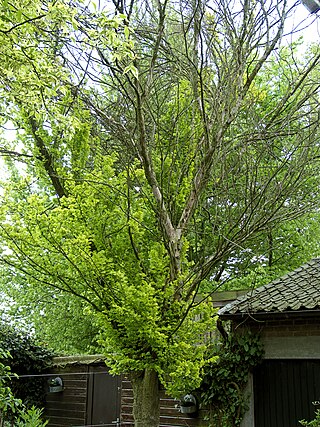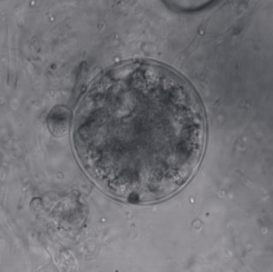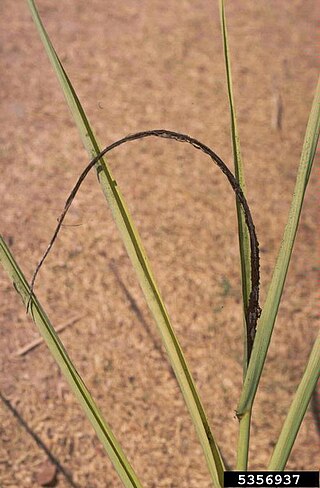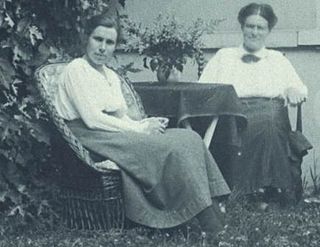Related Research Articles

Dutch elm disease (DED) is caused by a member of the sac fungi (Ascomycota) affecting elm trees, and is spread by elm bark beetles. Believed to be originally native to Asia, the disease was accidentally introduced into America, Europe, and New Zealand. In these regions it has devastated native populations of elms that did not have resistance to the disease. The name "Dutch elm disease" refers to its identification in 1921 and later in the Netherlands by Dutch phytopathologists Bea Schwarz and Christine Buisman, who both worked with professor Johanna Westerdijk. The disease affects species in the genera Ulmus and Zelkova, therefore it is not specific to the Dutch elm hybrid.

Chytridiomycota are a division of zoosporic organisms in the kingdom Fungi, informally known as chytrids. The name is derived from the Ancient Greek χυτρίδιον (khutrídion), meaning "little pot", describing the structure containing unreleased zoospores. Chytrids are one of the earliest diverging fungal lineages, and their membership in kingdom Fungi is demonstrated with chitin cell walls, a posterior whiplash flagellum, absorptive nutrition, use of glycogen as an energy storage compound, and synthesis of lysine by the α-amino adipic acid (AAA) pathway.

Passiflora edulis, commonly known as passion fruit, is a vine species of passion flower native to the region of southern Brazil through Paraguay to northern Argentina. It is cultivated commercially in tropical and subtropical areas for its sweet, seedy fruit.

Fusarium wilt is a common vascular wilt fungal disease, exhibiting symptoms similar to Verticillium wilt. This disease has been investigated extensively since the early years of this century. The pathogen that causes Fusarium wilt is Fusarium oxysporum. The species is further divided into formae speciales based on host plant.

Oak wilt is a fungal disease caused by the organism Bretziella fagacearum that threatens Quercus spp. The disease is limited to the eastern half of the United States; first described in the 1940s in the Upper Mississippi River Valley. The pathogen penetrates xylem tissue, preventing water transport and causing disease symptoms. Symptoms generally consist of leaf discoloration, wilt, defoliation, and death. The disease is dispersed by insect vectors and to adjacent trees through underground root networks. However, human spread is the most consequential dispersal method. Moving firewood long distances can potentially transport diseases and invasive species.

Verticillium is a genus of fungi in the division Ascomycota, and are an anamorphic form of the family Plectosphaerellaceae. The genus used to include diverse groups comprising saprobes and parasites of higher plants, insects, nematodes, mollusc eggs, and other fungi, thus the genus used to have a wide-ranging group of taxa characterised by simple but ill-defined characters. The genus, currently thought to contain 51 species, may be broadly divided into three ecologically based groups - mycopathogens, entomopathogens, and plant pathogens and related saprotrophs. However, the genus has undergone recent revision into which most entomopathogenic and mycopathogenic isolates fall into a new group called Lecanicillium.

Ulmus crassifoliaNutt., the Texas cedar elm or simply cedar elm, is a deciduous tree native to south-central North America, mainly in southern and eastern Texas, southern Oklahoma, Arkansas, and Louisiana, with small populations in western Mississippi, southwest Tennessee, and north-central Florida; it also occurs in northeastern Mexico. It is the most common elm tree in Texas. The tree typically grows well in flat valley bottom areas referred to as cedar elm flats. Its Latin name refers to its comparatively thick (crassifoliate) leaves; the common name cedar elm is derived from the trees' association with juniper trees, locally known as cedars.

Asteliaceae is a family of flowering plants, placed in the order Asparagales of the monocots.

Sugarcane smut is a fungal disease of sugarcane caused by the fungus Sporisorium scitamineum. The disease is known as culmicolous, which describes the outgrowth of fungus of the stalk on the cane. It attacks several sugarcane species and has been reported to occur on a few other grass species as well, but not to a critical amount. The most recognizable characteristic of this disease is a black or gray growth that is referred to as a "smut whip". Resistance to sugarcane smut is the best course of action for management, but also the use of disease free seed is important. On smaller scale operations treatments using hot water and removing infected plants can be effective. The main mode of spore dispersal is the wind but the disease also spreads through the use of infected cuttings. Sugarcane smut is a devastating disease in sugarcane growing areas globally.
The American Elm cultivar Ulmus americana 'Lake City' is a semi-fastigiate form cloned in the early 1920s from a ten-year old seedling found growing outside the Lutheran parsonage, Lake City, Minnesota, and released by the Lake City Nurseries there in 1931. The Nurseries published a nine-page booklet on it in 1932, 'The Lake City Elm', with full description, a photograph of the original tree, and commendatory letters. It was later described by Wyman in Trees Magazine 3 (4): 13, 1940.

Ophiostoma ulmi is a species of fungus in the family Ophiostomataceae. It is one of the causative agents of Dutch elm disease. It was first described under the name Graphium ulmi, and later transferred to the genus Ophiostoma.

Chondrostereum purpureum is a fungal plant pathogen which causes Silver leaf disease of trees. It attacks most species of the rose family Rosaceae, particularly the genus Prunus. The disease is progressive and often fatal. The common name is taken from the progressive silvering of leaves on affected branches. It is spread by airborne spores landing on freshly exposed sapwood. For this reason cherries and plums are pruned in summer, when spores are least likely to be present and when disease is visible. Silver Leaf can also happen on poming fruits like apples and pears. Plums are especially vulnerable.

Ascochyta is a genus of ascomycete fungi, containing several species that are pathogenic to plants, particularly cereal crops. The taxonomy of this genus is still incomplete. The genus was first described in 1830 by Marie-Anne Libert, who regarded the spores as minute asci and the cell contents as spherical spores. Numerous revisions to the members of the genus and its description were made for the next several years. Species that are plant pathogenic on cereals include, A. hordei, A. graminea, A. sorghi, A. tritici. Symptoms are usually elliptical spots that are initially chlorotic and later become a necrotic brown. Management includes fungicide applications and sanitation of diseased plant tissue debris.

Stegophora ulmea is a foliar disease of elms commonly known as black spot of elm, twig blight, and elm leaf scab. It is characterized by yellow spots that become black spots on the leaves. The pathogen is an ascomycete fungus native to North America. Stegophora ulmea is its teleomorph name. It has two anamorph names, Gloeosporium ulmicolom referring to the macroconidia stage and Cylindrosporella ulmea referring to the microconidia stage. This pathogen was formerly known as Gnomonia ulmea.

[[Image:|thumb|]] Cienfuegos Province Botanical Garden, officially, Jardín Botánico de Cienfuegos, also known as Jardín Botánico Soledad, is located 14 kilometres (8.7 mi) from Cienfuegos city centre.

Paul Carpenter Standley was an American botanist known for his work on neotropical plants.

Sugarcane or sugar cane is a species of tall, perennial grass that is used for sugar production. The plants are 2–6 m (6–20 ft) tall with stout, jointed, fibrous stalks that are rich in sucrose, which accumulates in the stalk internodes. Sugarcanes belong to the grass family, Poaceae, an economically important flowering plant family that includes maize, wheat, rice, and sorghum, and many forage crops. It is native to the warm temperate and tropical regions of India, Southeast Asia, and New Guinea.

Marie Beatrice "Bea" Schol-Schwarz was the Dutch phytopathologist who discovered the causal fungus of Dutch elm disease. She first studied pathogens afflicting peanuts and later the fungus Phialophora.
Forest Buffen Harkness Brown (1873–1954) was an American botanist known for his work on pteridophytes and spermatophytes.

Rhizoctonia is a genus of fungi in the order Cantharellales. Species form thin, effused, corticioid basidiocarps, but are most frequently found in their sterile, anamorphic state. Rhizoctonia species are saprotrophic, but some are also facultative plant pathogens, causing commercially important crop diseases. Some are also endomycorrhizal associates of orchids. The genus name was formerly used to accommodate many superficially similar, but unrelated fungi.
References
- ↑ "Carpenterella molinea". MycoBank. Retrieved 25 January 2016.
- ↑ Alexander Doweld. 2013. Nomenclatural novelties. Index Fungorum, No. 30, p. 1; http://www.indexfungorum.org/Publications/Index%20Fungorum%20no.30.pdf, accessed 25 Jan 2016.
- ↑ Leo R. Tehon & Hubert A. Harris (1941). "A chytrid inhabiting xylem in the Moline elm". Mycologia . 33 (1): 118–129. doi:10.1080/00275514.1941.12020799. JSTOR 3754743.
- ↑ Burkhardt, Lotte (2022). Eine Enzyklopädie zu eponymischen Pflanzennamen [Encyclopedia of eponymic plant names](pdf) (in German). Berlin: Botanic Garden and Botanical Museum, Freie Universität Berlin. doi:10.3372/epolist2022. ISBN 978-3-946292-41-8 . Retrieved January 27, 2022.
- ↑ C. W. Carpenter (1940). "A chytrid in relation to chlorotic streak disease of sugar cane". Hawaiian Planters Record . 44 (1): 19–33.
- ↑ Pan-Pacific Union: First Pan-Pacific Educational Conference, Honolulu, August 11–24, 1921, Program and Proceedings, p. 13; http://booksnow1.scholarsportal.info/ebooks/oca3/4/programproceedin00panpuoft/programproceedin00panpuoft.pdf.